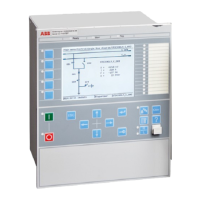The effect of changing power factor of the load will be that j2 will no longer be close to -90°
resulting in U
L
being smaller or greater than U
B
if the ratio Rline/Xline is not adjusted.
Figure 163 shows an example of this where the settings of
Rline
and
Xline
for j = 11° from
figure 162 has been applied with a different value of j (j = 30°).
U
B
jI
T
*Xline
U
L
Xline
Rline
Zline
I
T
I
T
*Rline
j=30
0
j
1
j
2
DU
j
1
=11
0
-90
0
=-79
0
en06000630.vsd
IEC06000630 V1 EN-US
Figure 163: Transformer with reverse reactance regulation poorly adjusted to the power
factor
As can be seen in figure 163, the change of power factor has resulted in an increase of j2 which
in turn causes the magnitude of U
L
to be greater than U
B
. It can also be noted that an increase
in the load current aggravates the situation, as does also an increase in the setting of Zline
(
Rline
and
Xline
).
Apparently the ratio Rline/Xline according to equation 128, that is the value of j1 must be set
with respect to the power factor, also meaning that the reverse reactance method should not
be applied to systems with varying power factor.
The setting of
Xline
gives the sensitivity of the parallel regulation. If
Xline
is set too low, the
transformers will not pull together and a run away tap situation will occur. On the other hand, a
high setting will keep the transformers strongly together with no, or only a small difference in
tap position, but the voltage regulation as such will be more sensitive to a deviation from the
anticipated power factor. A too high setting of
Xline
can cause a hunting situation as the
transformers will then be prone to over react on deviations from the target value.
There is no rule for the setting of
Xline
such that an optimal balance between control response
and susceptibility to changing power factor is achieved. One way of determining the setting is
by trial and error. This can be done by setting e.g.
Xline
equal to half of the transformer
reactance, and then observe how the parallel control behaves during a couple of days, and then
tune it as required. It shall be emphasized that a quick response of the regulation that quickly
pulls the transformer tap changers into equal positions, not necessarily corresponds to the
optimal setting. This kind of response is easily achieved by setting a high
Xline
value, as was
discussed above, and the disadvantage is then a high susceptibility to changing power factor.
A combination of line voltage drop compensation and parallel control with the negative
reactance method is possible to do simply by adding the required
Rline
values and the required
Xline
values separately to get the combined impedance. However, the line drop impedance has
a tendency to drive the tap changers apart, which means that the reverse reactance
impedance normally needs to be increased.
Section 13 1MRK 511 358-UEN A
Control
328
Application manual

